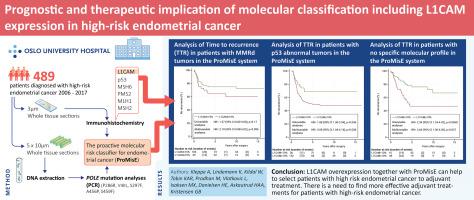包括 L1CAM 表达在内的分子分类对高危子宫内膜癌的预后和治疗意义。
IF 4.5
2区 医学
Q1 OBSTETRICS & GYNECOLOGY
引用次数: 0
摘要
导言:分子分类和L1CAM在高危子宫内膜癌中的作用尚不确定。我们旨在确定分子图谱和 L1CAM 与复发和生存模式的关联:这项回顾性队列研究纳入了2006年1月1日至2017年12月31日期间转诊至奥斯陆大学医院妇科肿瘤部的患者。根据 ProMisE 进行了 L1CAM 表达和分子谱分析。主要结果是复发时间(TTR)和癌症特异生存率(CSS):在489名患者中,486人可进行分子分类。37例(8%)为POLE突变肿瘤,148例(30%)为MMRd肿瘤,189例(39%)为p53异常肿瘤,112例(23%)为NSMP肿瘤。在 256 例(53%)肿瘤中观察到 L1CAM 高表达,在 227 例(46%)肿瘤中观察到 L1CAM 低表达(6 例(1%)缺失)。在多变量分析中,ProMisE对TTR有显著影响,但对CSS无显著影响。在多变量分析中,L1CAM 对 TTR 和 CSS 均有显著影响。在将 ProMisE 和 L1CAM 表达纳入同一多变量模型的多变量模型中,ProMisE 失去意义,而 L1CAM 仍有意义。POLE突变的肿瘤患者预后良好,而p53异常或L1CAM过度表达的肿瘤患者预后较差,远处复发的频率较高。MMRd肿瘤、NSMP和p53异常但L1CAM较低的肿瘤患者预后居中:结论:L1CAM是p53异常组和NSMP组的额外不利因素。结论:L1CAM是p53异常组和NSMP组的额外不利因素,在加强辅助治疗的研究中需要特别关注这些组别。本文章由计算机程序翻译,如有差异,请以英文原文为准。

Prognostic and therapeutic implication of molecular classification including L1CAM expression in high-risk endometrial cancer
Introduction
The role of molecular classification and L1CAM in high-risk endometrial cancer is uncertain. We aimed to determine the association of molecular profiling and L1CAM with patterns of relapse and survival.
Material and methods
This retrospective cohort study included patients referred to Department for Gynecologic Oncology, Oslo University Hospital between January 1, 2006 and December 31, 2017. L1CAM expression and molecular profiling according to ProMisE was performed. Main outcome was time to recurrence (TTR) and cancer specific survival (CSS).
Results
Of 489 patients, 486 could be molecular classified. Thirty-seven (8 %) had POLE mutated tumors, 148 (30 %) had MMRd tumors, 189 (39 %) had p53 abnormal tumors, and 112 (23 %) had NSMP tumors. High L1CAM expression was observed in 256 (53 %), low in 227 (46 %) tumors (6 (1 %) missing). ProMisE was significant for TTR but not for CSS in multivariable analysis. L1CAM was significant in multivariable analysis for both TTR and CSS. In a multivariable model with ProMisE and L1CAM expression in the same multivariable model, ProMisE lost significance while L1CAM remained significant. Patients with POLE mutated tumors entailed an excellent prognosis while patients with p53 abnormal or L1CAM overexpressing tumors entailed a poor prognosis with a high frequency of distant recurrences. Patients with MMRd tumors, NSMP and p53 abnormal tumors with low L1CAM had an intermediate prognosis.
Conclusions
L1CAM is an additional adverse factor in the p53 abnormal and NSMP groups. These groups need special attention in studies intensifying adjuvant treatment.
求助全文
通过发布文献求助,成功后即可免费获取论文全文。
去求助
来源期刊

Gynecologic oncology
医学-妇产科学
CiteScore
8.60
自引率
6.40%
发文量
1062
审稿时长
37 days
期刊介绍:
Gynecologic Oncology, an international journal, is devoted to the publication of clinical and investigative articles that concern tumors of the female reproductive tract. Investigations relating to the etiology, diagnosis, and treatment of female cancers, as well as research from any of the disciplines related to this field of interest, are published.
Research Areas Include:
• Cell and molecular biology
• Chemotherapy
• Cytology
• Endocrinology
• Epidemiology
• Genetics
• Gynecologic surgery
• Immunology
• Pathology
• Radiotherapy
 求助内容:
求助内容: 应助结果提醒方式:
应助结果提醒方式:


